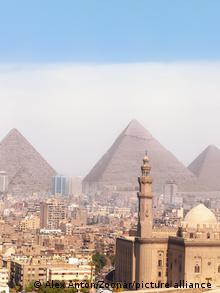On July 19, 1799, French soldiers pulled an inconspicuous stone slab out of the rubble of a demolition wall in Rosetta, a port city on the Nile Delta. Three blocks of writing are carved into the surface. None of the men taking part in Napoleon’s Egyptian campaign (1798-1801) and preparing to fight the troops of the Ottoman Empire has any idea of the treasure they are holding in their hands. But the news soon spread like wildfire.

Egypt in the light of its ancient heritage: The Rosetta Stone was discovered in the Nildeta – the key to ancient Egypt
The rock tablet made of a granite-like, magmatic rock, just 112 centimeters high and 75.7 centimeters wide, turns out to be a fragment of a much larger ancient stele. But what do the inscriptions, the letters and symbols, mean? The plate is damaged: two thirds of the upper text, illegible hieroglyphs, are missing. In addition, many lines are damaged at the edge. The middle text in Demotic script, an ancient Egyptian script, is the best preserved. A large corner piece is missing from the lower – ancient Greek – text.
A mysterious find
But what do the three texts mean? Are they identical messages in different languages and scripts? Lieutenant Pierre-François Bouchard, commander of the Napoleonic Expeditionary Corps, is completely intrigued. The riddle gives him no rest. He informed French archaeologists who had traveled with him. But even they have no explanation and want to take the find to France for further investigation. However, this failed in 1801 due to the victory of English troops over the French. The vanquished must hand over all of their ancient Egyptian artifacts. And so the Rosetta Stone ended up in London as spoils of war. To this day he willBritish Museum issued.
Electrified by the mysterious find, researchers from all over Europe are now beginning to decode the writings. The Frenchman Silvestre de Sacy first compares the demotic with the Greek part of the text. In 1802, the Swede Johan David Åkerblad managed to read the Demotic names, which was a continuation of Sacy’s work. The British polymath Thomas Young, on the other hand, tries to solve the riddle of the writings in a mathematical way, but he does not understand the complex grammar of the ancient Egyptian writing.
Linguist Champollion: “I got it!”
It was Jean-François Champollion (1790-1832), a French linguist, who finally made the breakthrough: Unlike Young, he speaks Coptic fluently and knows a lot about Egypt and its culture. And he discovers that the characters of the Demotic script stand for syllables, while the Ptolemaic hieroglyphs in turn reflect sounds of the Coptic language. “This enabled Champollion to prove that the Coptic language is behind the hieroglyphic writing,” Egyptologist Christian Loeben from Hanover told DW. “That’s how he deciphered the hieroglyphs.”
Full of ecstasy, Champollion is said to have run into his brother’s office and loudly “Je tiens mon affair!” (“I’ve got it!”) – only to faint.
Egyptian hieroglyphs – a pictorial script using human figures, animals and things – were in use from around 3000 BC to 400 AD. Soon after, no one could read her anymore. But where did the Rosetta Stone come from? And what were the engraved writings about?
Hieroglyphs reflect sounds of the Coptic language
Scientists assume that the stele was made around 196 BC. in the Ptolemaic era (c. 323 to 30 BC). was made. The rule of the Ptolemaic dynasty had been threatened by power struggles since the death of Ptolemy IV. When 204 BC When a revolt broke out, loyalty to the pharaoh was required. This is how an Egyptian synod of priests formulated it in 196 BC. the so-called “Decree of Memphis”. It was written in such a way that three groups of people could read it: for the priests as God’s words in hieroglyphs, for the officials in Egyptian in demotic letters, and for the Greek rulers of Egypt in ancient Greek in Greek capital letters. Identical stelae should be placed in every temple in Egypt.
Using the Rosetta Stone, Jean-François Champollion created an alphabet of phonetic hieroglyphs. Other scholars were able to fully translate the inscription with it. “Thanks to the Rosetta Stone, Champollion was able to decipher the hieroglyphs. This gave the Egyptians their voices again,” says Loeben, who heads the Egyptian department at the Kestner Museum in Hanover. “At the same time, this marked the birth of Egyptology.”
controversy about the owners
To this day, the Rosetta Stone is considered one of the most important archaeological finds of all. Its importance is huge – not only for science. After all, who owns the artefact that came to England during the colonial period? “The stone belongs to humanity, no matter where it is,” says German Egyptologist Loeben. “Egyptian objects in the museums of the world are Egypt’s best ambassadors outside the country.” Tourism also benefits from this, which ultimately brings money to the land of the pharaohs.
Loeben is currently preparing a large exhibition on the Rosetta Stone for the Roemer and Pelizaeus Museum in Hildesheim. The show “Deciphered” begins on September 9, 2023. From October 13, 2022, a major exhibition at the British Museum in London the discovery achievements of the researchers – exactly 200 years after the decoding of the hieroglyphs.













